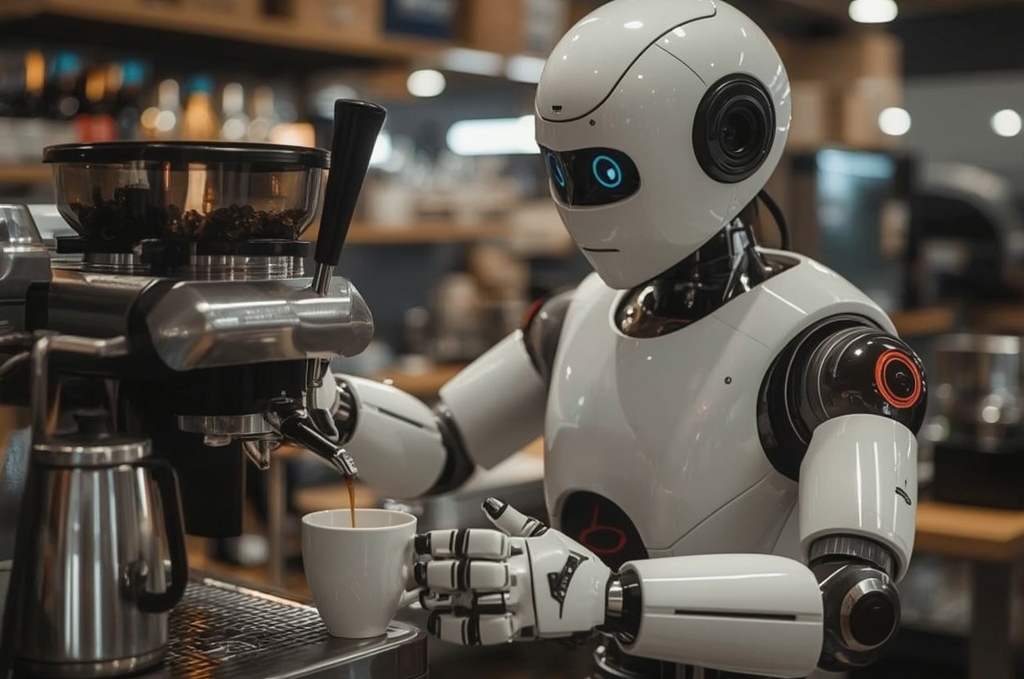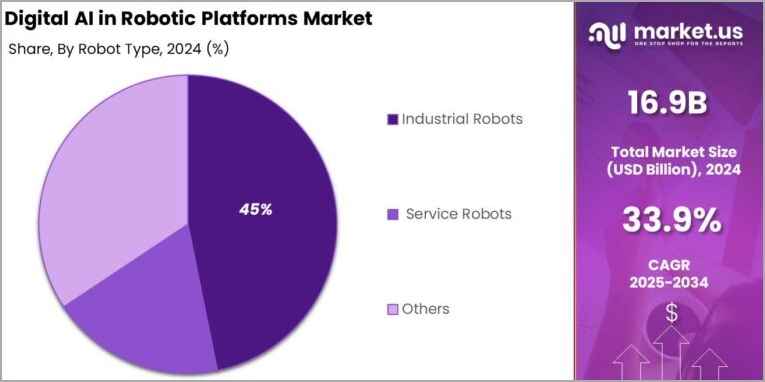

A robot served me coffee at a conference once. And while the experience of being served coffee by a robot illustrates an intriguing mix of novelty and utility at the heart of advanced AI-driven robotics, the very same technology is powerfully solving a variety of real-world problems across multiple industries.
Take Richtech Robotics (NASDAQ:RR), for example, the company behind ADAM, the dual-armed robotic barista that made my coffee. Richtech Robotics' AI robots excel not just because they pour coffee, but because they integrate automation, AI, and data to answer critical challenges like labor shortages, demand for consistency and safety, and the need for 24/7 high-quality service. They are thoughtfully designed to complement human workers, increase operational resilience, and help organizations grow sustainably in a demanding world that goes far beyond conference catering.
To fully appreciate the impact of AI in robotics like this we must first grasp the magnitude and evolution of the robotics market.
Navigating the Expanding AI-Powered Robotics Market

Source: AI-Generated by Andre Bourque
The clanking of gears and whirring of motors are no longer confined to sci-fi thrillers. We are on the precipice of a profound technological shift, one where artificial intelligence breathes life into automation, unleashing a torrent of innovation across industries. And these AI Robots are popping up everywhere. The 20th season of America's Got Talent has even seen robotics take center stage with Boston Dynamics robots dancing to Queen's "Don't Stop Me Now."
The global robotics industry is projected to reach a value of $165.2 billion by 2029, with a CAGR of 16.1%. In 2024, robotics startups attracted roughly $6.1 billion in funding, up 19% from 2023.

Source: PitchBook
AI integration, cost reduction, and the development of humanoid robots are key drivers of this growth. New opportunities are emerging in areas beyond traditional hardware, fueled by advancements in AI technology.
For discerning investors and AI enthusiasts alike, the burgeoning landscape of AI robotics presents an unparalleled opportunity, a frontier where venture capital pours into companies poised to redefine work, life, and productivity. The confluence of advancements in AI and robotics is not merely a trend; it’s a fundamental reimagining of capabilities. As JPMorgan's recent report aptly puts it, robotics and automation are surging as investors back “science made real.”
The question for smart money isn’t if AI robotics will reshape the world, but how quickly, and who will capture the lion’s share of its immense value.
The Evolving Landscape of AI Robotics Investments
The robotics industry has seen remarkable growth in recent years, with AI integration serving as a primary catalyst. According to a comprehensive report by Marion Street Capital, global investments in robotics companies are projected to exceed $40 billion by the end of 2025, representing a 35% increase from 2023 levels. This illustrates a fundamental shift in how investors perceive robotics, whereas, what was once considered a specialized industrial technology is now recognized as a foundational element of the next technological revolution, particularly when enhanced by advanced AI capabilities.
Some notable AI robotics funding rounds include:
- Figure AI’s $675 million raise from investors including Microsoft and OpenAI
- Sanctuary AI's $140 million in funding for the development of humanoid robots
- $100 million in VC funding for Path Robotics, an AI-enabled robotic welding solution
- Robot brain startup Physical Intelligence with a $400 million infusion at a $2 billion valuation
Key Trends
Several critical trends underpin the current and projected growth within AI-driven robotics. One major trend is the increasing complexity of capital raising in the robotics sector. Securing funding for robotics ventures requires a nuanced approach that demonstrates both long-term technological promise and near-term commercial viability. Investors are showing a clear preference for companies that present well-defined pathways to scalable deployment and market traction.
In addition, there is a notable rise in specialized robotics venture capital firms. Institutions like Grishin Robotics, Reinforced Ventures, and Bee Partners have developing specialized funds dedicated to supporting early- to growth-stage AI robotics startups. These focused investment vehicles bring valuable domain expertise, which helps to de-risk investments in this technologically sophisticated sector and supports emerging companies on their growth journeys.
AI Robotics Sectors and Innovations
McKinsey’s latest “Top Trends in Tech” report positions AI-powered robotics among the top three transformative technologies of the decade. The report highlights that companies implementing AI robotics solutions are experiencing productivity improvements averaging 28% across four sectors.
1. Industrial Automation and Manufacturing
This is arguably the most mature segment for robotics, but AI is breathing new life into it. Traditional industrial robots were often rigid and pre-programmed. The integration of AI, particularly machine vision and machine learning, has transformed them into adaptive and intelligent automation systems. So much, in fact, that in 2024, this AI robotic segment held a dominant market position capturing more than a 45% share.

Source: Market US
Companies developing flexible manufacturing solutions, AI-powered quality inspection systems, and advanced robot programming platforms are highly sought after. Investors are also eyeing firms specializing in “lights-out” manufacturing where human intervention is minimal.
Trends in this category include:
- Collaborative Robots (Cobots): AI enhances the ability of cobots to work safely alongside humans, adapting to unpredictable human movements and tasks. This reduces the need for extensive safety caging, making automation accessible to smaller and medium-sized enterprises (SMEs).
- Generative AI for Robot Design and Programming: Leveraging AI to design optimal robot configurations and even generate code for complex tasks significantly reduces development time and costs.
- Predictive Maintenance and Quality Control: AI algorithms analyze sensor data from robots to predict equipment failures before they occur, minimizing downtime. Vision AI systems detect manufacturing defects with unparalleled accuracy, even on fast-moving production lines.
2. Logistics and Supply Chain Automation
Global e-commerce sales are projected to hit $8.03 trillion by 2027. This surge in investment is not just about accelerating speed, it's also about enhancing accuracy and resilience in the supply chain, with robots like autonomous mobile vehicles and AI-powered sorting arms optimizing processes, ensuring businesses stay competitive in an increasingly digital economy.
Companies innovating in warehouse automation, fleet management software for AMRs, and intelligent sorting systems are seeing substantial capital injections. Startups developing outdoor autonomous delivery solutions are also on investors’ radar, despite longer timelines to commercialization.
Trends here include:
- Autonomous Mobile Robots (AMRs): Unlike traditional automated guided vehicles (AGVs), AMRs use AI to navigate dynamic warehouse environments without fixed pathways, optimizing routing and increasing throughput.
- Automated Storage and Retrieval Systems (AS/RS): AI fine-tunes picking, packing, and sorting processes, making warehouses hyper-efficient.
- Last-Mile Delivery Bots and Drones: While still facing regulatory hurdles, significant investment is flowing into AI-powered autonomous vehicles for urban and suburban last-mile delivery, promising significant cost reductions.
3. Healthcare Robotics
The healthcare sector is grappling with aging populations, rising costs, and a demand for higher quality care. AI robotics offers solutions across various applications. The robotic-assisted surgery market alone is expected to climb to $14 billion globally by 2026, with a CAGR of nearly 11%. All driven by technology upgrades, increased demand for minimally invasive procedures, and improved patient outcomes.

Source: Oliver Wyman
Companies specializing in surgical robotics, diagnostic AI tools that can be integrated with robotic platforms, and advanced rehabilitation devices are attracting significant funding. There’s also growing interest in “care robots” for aging-in-place solutions.
Trends in this AI robotics category include:
- Surgical Robotics: AI is enhancing precision in minimally invasive surgeries, enabling more complex procedures with faster recovery times. Future developments include AI-assisted anomaly detection during surgery.
- Rehabilitation and Assistive Robotics: AI-powered exoskeletons, prosthetic limbs, and therapy robots are revolutionizing physical rehabilitation and improving quality of life for individuals with disabilities.
- Hospital Logistics and Patient Care: Robots are being deployed for tasks like delivering medications, cleaning, and sanitizing, freeing up human staff for more critical patient interactions.
4. Service Robotics

Source: AI-Generated by Andre Bourque
Beyond industrial and healthcare settings, service robots powered by AI are making inroads into hospitality, retail, food service, and even domestic environments. The global service robotics market size is predicted to increase from $47 billion in 2024 to roughly $98 billion by 2029. Food service automation (e.g., burger-flipping robots), automated cleaning solutions, and advanced agricultural robots are areas of growing investor intrigue.
In the service robotics sector, the experience is the product, and that product needs to have near 100% uptime. "There's nothing more exciting than seeing a robot functioning in ways humans might," Matt Casella, the president of Richtech Robotics told me. "But there's nothing worse than seeing a robot in the corner collecting dust."
Trends in this space include:
- Customer Service Bots: AI-driven humanoid or specialized robots engaging with customers in retail or hospitality, offering information or taking orders.
- Cleaning and Maintenance Bots: Advanced AI navigation and perception enable robots to clean large commercial spaces or even homes more efficiently.
- Agricultural Robotics: AI visual processing allows robots to precisely identify ripe produce, target weeds for removal, and monitor crop health, leading to reduced waste and increased yields.
Investor Insights and Strategies
Ultimately, the same AI-powered systems that spark conference memories, like a robot-made cappuccino, are also driving monumental shifts in industries that demand reliability, safety, and efficiency. Indeed, the robots-as-a-service (RAAS) phenomena may very well be the multi-industry solution for the 21st century and beyond, but the industry is still nascent. "We're not too early, but we're early," Casella said.
For investors seeking to capitalize on the growth of AI robotics, one key strategy is to focus on vertical integration. By investing in companies that build both AI software and robotics hardware platforms, investors can help create stronger competitive moats, positioning these companies to outperform in the market. Another recommended approach is partnering with established corporates. Robotics startups often benefit from collaborations with well-established industrial firms, which can accelerate the prototyping process and help scale the deployment of new solutions more efficiently.
Additionally, diversifying investments across different subsectors is advised. Spreading capital across a range of applications can help mitigate sector-specific risks and provide more stable returns. Finally, emphasizing data and AI expertise is paramount. Since AI serves as the "brain" of robotic systems, it is essential to back teams with strong AI research backgrounds. This expertise is considered critical for achieving long-term success in the rapidly evolving AI robotics industry.
Feature Image: AI-Generated by Andre Bourque
Benzinga Disclaimer: This article is from an unpaid external contributor. It does not represent Benzinga’s reporting and has not been edited for content or accuracy.



